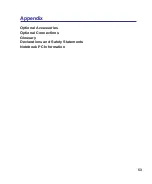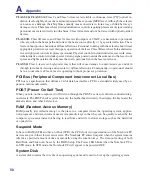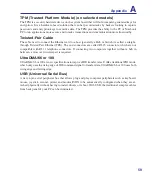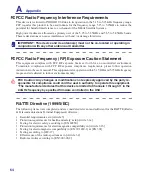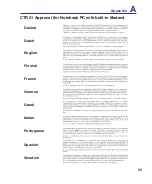
5
A
Appendix
CLASS 2 & CLASS 3A: Class 2 and Class 3A lasers emit visible, continuous-wave (CW) optical ra-
diation levels slightly above the maximum permissible exposure (MPE) level. Although these lasers
can cause eye damage, their brightness usually causes observers to look away or blink before eye
damage occurs. These lasers have strict administrative controls requiring placement of signs warning
personnel not to stare directly into the beam. Class 3A lasers must not be viewed with optically-aided
devices.
CLASS 3B: Class 3B lasers, and Class 3A lasers with outputs of 2.5mW, are hazardous to personnel
who are within the beam path and look at the beam source directly or by specular reflection. These
lasers cannot produce hazardous diffuse reflections. Personnel working with these lasers should wear
appropriate protective eyewear during any operation of the laser. Class 3B lasers have both administra-
tive and physical controls to protect personnel. Physical controls include limited access work areas.
Administrative controls include special warning signs posted outside the entrances to the laser work
spaces and lights outside the entrances that warn personnel when the lasers are in use.
CLASS 4: Class 4 lasers are high-power lasers that will cause damage to unprotected eyes and skin
through intra-beam viewing and specular or diffuse reflections. Consequently, no personnel should
be in a room where a Class 4 laser is operating without proper eye protection.
PCI Bus (Peripheral Component Interconnect Local Bus)
PCI bus is a specification that defines a 32-bit data bus interface. PCI is a standard widely used by ex
-
pansion card manufacturers.
POST (Power On Self Test)
When you turn on the computer, it will first run through the POST, a series of software-controlled diag
-
nostic tests. The POST checks system memory, the motherboard circuitry, the display, the keyboard, the
diskette drive, and other I/O devices.
RAM (Random Access Memory)
RAM (usually just called memory) is the place in a computer where the operating system, applica-
tion programs, and data in current use are temporarily kept so that they can be quickly reached by the
computer’s processor instead of having to read from and write to slower storage such as the hard disk
or optical disc.
Suspend Mode
In Save-to-RAM (STR) and Save-to-Disk (STD), the CPU clock is stopped and most of the Notebook PC
devices are put in their lowest active state. The Notebook PC enters Suspend when the system remains
idle for a specified amount of time or manually using the function keys. The time-out setting of both
Hard Disk and Video can be set by the BIOS Setup. The Power LED blinks when the Notebook PC is
in STR mode. In STD mode, the Notebook PC will appear to be powered OFF.
System Disk
A system disk contains the core file of an operating system and is used to boot up the operating system.
Содержание Z84J
Страница 1: ...Notebook PC Hardware User s Manual E2925 Nov 2006 ...
Страница 4: ... Contents ...
Страница 10: ...10 1 Introducing the Notebook PC ...
Страница 22: ...22 2 Knowing the Parts ...
Страница 52: ...52 4 Using the Notebook PC ...










